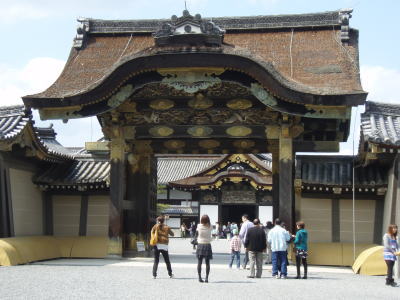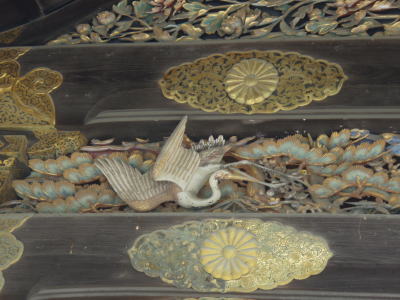Last update September 27, 2022
二条城
Nijo Castle


|
壮大な時代の始まりと終わりの舞台となった二条城
Witnessing Both the Start and End of an Era
二条城概要
 江戸幕府の初代将軍、徳川家康が、1603年(慶長8年)に作ったんだけど、自分が京都に来たときの「お泊り用御殿」として建てたらしいわよ。その後、3代将軍の家光が豊臣秀吉のお城だった伏見城の遺構を移したりして、完成したのが1626年(寛永3年)。
江戸幕府の初代将軍、徳川家康が、1603年(慶長8年)に作ったんだけど、自分が京都に来たときの「お泊り用御殿」として建てたらしいわよ。その後、3代将軍の家光が豊臣秀吉のお城だった伏見城の遺構を移したりして、完成したのが1626年(寛永3年)。
 つまり、豊臣秀吉が残した永禄年間の遺構と、家康が建てた慶長年間の建築、そして家光がつくらせた絵画・彫刻がミックスされてんのね。桃山時代様式の全貌が表されてるらしいわ。すごいわね。
つまり、豊臣秀吉が残した永禄年間の遺構と、家康が建てた慶長年間の建築、そして家光がつくらせた絵画・彫刻がミックスされてんのね。桃山時代様式の全貌が表されてるらしいわ。すごいわね。
その後、江戸時代最後の将軍である慶喜が、1867年に大政奉還ってのをやって明治時代になるんだけど、このときに、朝廷にあげちゃったらしいわ。もったいないわね。1884年(明治17年)には「離宮」になって、1939年(昭和14年)に京都市のものになったということなのよ。
Outline of Nijo Castle
The early Nijo Castle buildings were built in 1603 by Tokugawa Ieyasu, the first shogun of the Tokugawa reign, as his villa in Kyoto. The third shogun Iemitsu expanded it by integrating the structures moved from Fushimi Castle, once properties of Toyotomi Hideyoshi, and completed the enhancement in 1626.
With the Fushimi Castle remains incorporated, Nijo Castle presents itself as a panoramic showcase of glamorous styles of the Momoyama period (1573 - 1614), manifesting a sophisticated blend of tastes and styles of the three rulers of the time: Hideyoshi, Ieyasu, and Iemitsu. The third added painting and sculpture decorations to the castle.
 When Tokugawa Yoshinobu, the fifteenth and the last shogun of the shogunate returned the reign to the emperor in 1867, the castle was offered to the imperial family. It changed the name to Nijo Detached Palace in 1884. In 1939 the properties were donated to Kyoto city and renamed Nijo Castle. It has been opened to the public since then.
When Tokugawa Yoshinobu, the fifteenth and the last shogun of the shogunate returned the reign to the emperor in 1867, the castle was offered to the imperial family. It changed the name to Nijo Detached Palace in 1884. In 1939 the properties were donated to Kyoto city and renamed Nijo Castle. It has been opened to the public since then.



 江戸幕府の初代将軍、徳川家康が、1603年(慶長8年)に作ったんだけど、自分が京都に来たときの「お泊り用御殿」として建てたらしいわよ。その後、3代将軍の家光が豊臣秀吉のお城だった伏見城の遺構を移したりして、完成したのが1626年(寛永3年)。
江戸幕府の初代将軍、徳川家康が、1603年(慶長8年)に作ったんだけど、自分が京都に来たときの「お泊り用御殿」として建てたらしいわよ。その後、3代将軍の家光が豊臣秀吉のお城だった伏見城の遺構を移したりして、完成したのが1626年(寛永3年)。 つまり、豊臣秀吉が残した永禄年間の遺構と、家康が建てた慶長年間の建築、そして家光がつくらせた絵画・彫刻がミックスされてんのね。桃山時代様式の全貌が表されてるらしいわ。すごいわね。
つまり、豊臣秀吉が残した永禄年間の遺構と、家康が建てた慶長年間の建築、そして家光がつくらせた絵画・彫刻がミックスされてんのね。桃山時代様式の全貌が表されてるらしいわ。すごいわね。 When
When 